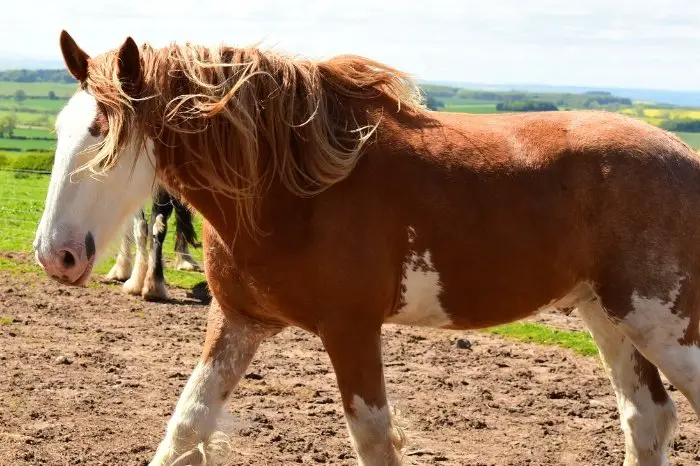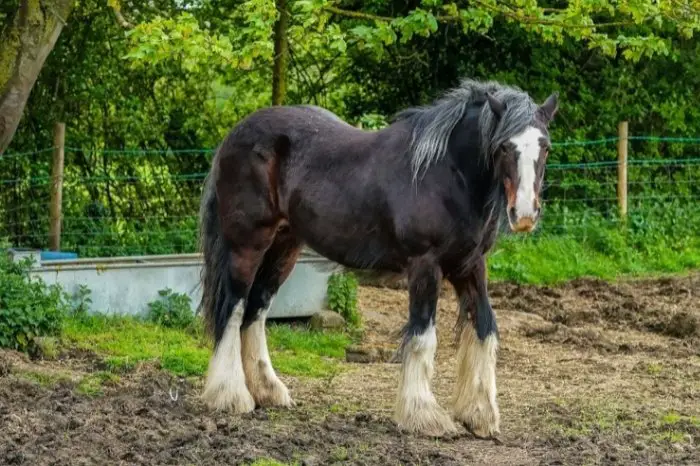Last Updated on March 14, 2022
We all know that horses have beautiful manes and tails, but some horses take things a step further, so let’s take a look at horse breeds with long hair. These breeds have specific genes that result in them growing more hair than other breeds. This extra hair is a result of the breed’s evolution and the environment they come from.
Clydesdale
The Clydesdale is the most recognizable of the horse breeds with long hair. The breed is famous for pulling the Budweiser carriages at demonstrations all over the United States. It is a draft horse that comes from Scotland.
When Scotland was in need of bigger stronger horses to work on farms, estate owners imported heavy horses to cross with local mares. With selective breeding in the 18th century, the Clydesdale Horse Society took shape a hundred years later, in 1877.
The Clydesdale is a type of draft breed. It is one of the biggest horses in the world, standing on average between 17 and 18 hands tall. Most Clydesdales are bay with white leg and face markings.
While the body of the Clydesdale does not have any more hair than other horse breeds, their legs have luxurious feathering. This long hair is silky and adds to the flair of this active moving breed. It has some of the thickest and heavy feathers of any other breed.
Gypsy Vanner
The Gypsy Vanner is a small draft horse, from Ireland and the United Kingdom. The breed comes from the Romani people, who needed a strong horse to pull their caravans, but a horse that did not require a lot of food. Unlike, other draft breeds, the Gypsy Vanner comes in many acceptable colors.
The majority of Vanners are black and white or bay and white. The Romani people took in horses that others did not want. This includes colored Shires, Hackneys, and any solidly built horse. All of this mixing gave us the Gypsy Vanner.
Gypsy Vanners have long, very thick leg feathers, similar to a Clydesdale. It is a smaller long hair breed that stands an average of 15 hands tall. Today, Gypsy Vanners don’t pull caravans very often anymore but work as quiet, sturdy riding horses.
Friesian
The Friesian is one of the world’s oldest horse breeds. In the Middle Ages, Friesians were the mounts of knights, who needed a bold, strong, brave companion to enter into battle. During the 1800s, the breed went through a change, becoming lighter and more agile.
World War I nearly saw the end of the Friesian. After the war, only a few mares and one stallion were left. Breeders in the breed’s homeland of Friesland, northern Netherlands, took on saving the breed. If it wasn’t for these people, we would have lost this beautiful breed.
The Friesian has leg feathering from the fetlock down and a very thick mane and tail. The Friesian is black in color with little to no white markings.
Icelandic Horse
For the next horse breed with long hair, we will step away from those with leg feathering and look at the Icelandic Horse. The Icelandic horse is one of the purest horse breeds in the world, with little to no crossing breeding in the last 1,000 years. Strict breeding ensures the unique fifth gait of the Icelandic horse, the tolt is preserved.
The breed descends from horses that came to Iceland with the Vikings. The harsh conditions of their Scandanavian and then Icelandic home created a breed that can survive extreme temperatures and very little food.
Every part of the Icelandic Horse grows the very thick, long winter coats it needs to protect it from frigid temperatures. This coat is up to 6 inches long. It is also has a double coat, and a narrower windpipe to protect the lungs from freezing.
Shire
The Shire is another draft breed with long hair, primarily on its legs. Like the Clydesdale, the Shire comes from the United Kingdom, this time from England. It is the largest of the draft breeds and boasts the tallest ever horse, Sampson, who stood 21.25 hands tall.
In the 1800s, Flemish horses and descendants of the British Great Horse were part of a breeding program to produce a strong, large horse to work on farms. The Shire does not have as much leg feathering as the Clydesdale.
The majority of Shire horses are bay, grey, or black. Chestnut is not an acceptable color within the breed standards. While all draft horses have incredible strength, the Shire is the strongest. A report from the 1920s states that a pair of Shire horses moved a load weighing 42 tons.
Long Haired Horse Breeds Conclusion
We’ve introduced you to some of the most interesting horse breeds with long hair, but they aren’t the only ones. Other breeds with long hair include the Fell Pony, Dales Pony, and the Swedish Northern Horse.
Long hair comes from environmental factors for which the horse had to adapt for survival. Do you have a favorite hairy horse breed? Let us know in the comments.
What is the horse with the longest hair?
Prince Imperial was the horse with the longest forelock (7 ft) and longest mane (9 ft 10 inches) in the world. The mane was later described as 14 ft 3 inches at its longest.
This famous long-haired horse was a Percheron and is believed to have been one of the first Percherons imported into the USA. Prince Imperial was first owned by Napoleon’s nephew, Emperor Charles Louis Napoleon Bonaparte III. Later he was bought by Jacob Howser, who took him to the USA to improve local bloodlines. As a horse with the longest forelock and mane in the world, Prince Imperial was traveling all over the USA to be exhibited at horse shows and fairs. After his death in 1888, his body was taxidermied and the Howser family continued to exhibit him during sideshow season for many years.
What horse has the longest mane and tail?
A Friesian horse is a beautiful beast with a strong, graceful stride and a long, flowing mane and tail. The breed is known for a brisk, high-stepping trot. The Friesian is a light draught horse originating in the Netherlands. It is well known for its grace and elegance. It is believed that ancestors of Friesian horses were in great demand for war horses throughout the continental Europe. Through the Early Middle Ages and High Middle Ages, their size enabled them to carry a knight in armour. In the Late Middle Ages, heavier, draught type horses were needed for the work at the farm and for pulling carts and Friesians were not that sought for anymore. Though the breed nearly became extinct on more than one occasion, the modern day Friesian horse is growing in numbers and popularity.
Why do Icelandic horses have long hair?
The Icelandic horse is an animal native to Iceland. During the winter months it is able to grow long hair to protect itself from the cold. They are known to be hardy animals, and will not shy away from humans. In addition, they are known for their intelligence and stamina. It is a small horse, standing between 12.2-13.2 hands. The Icelandic horse has a short, muscular neck, with a well-defined withers and sturdy body. It’s a sturdy and hardy breed, but also one that is sometimes described as lacking in elegance. The best characteristics of the breed include versatility in riding performance, lively temperament, and a strong but manageable temperament.
Why do Clydesdale horses have hairy feet?
The highland cattle of Scotland may have adapted to the harsh conditions by developing longer fur to keep their bodies warm. During the summer, the high temperatures in Scotland rarely exceed 20 degrees Celsius and in the winter it’s common that the snow covers the ground for about 100 days a year. This is one harsh environment so it’s no surprise that animals, including horses, adapted to the cold weather in different ways. This is also the reasons the Clydesdales have such long, thick hair on their feet. Those long hair help keep them warm during the colder months.
Michael Dehaan is a passionate horse owner, horse rider, and lover of all things equine. He has been around horses since he was a child, and has grown to become an expert in the field. He has owned and ridden a variety of horses of different breeds, and has trained many to compete in shows and competitions. He is an experienced horseman, having worked with and competed many horses, including his own. He is an active member of the equestrian community, participating in events and teaching riding lessons.



